INTRODUCTION
Judaism, one of the world’s oldest religions, has undergone numerous transformations throughout history. Among these, the transition from what is often called “Biblical” or “Temple” Judaism to Rabbinic Judaism represents a fundamental shift that has shaped the practices and beliefs of Jewish communities worldwide. This article will explore the distinctive features of Rabbinic Judaism and compare it with its predecessor.
BIBLICAL JUDAISM
Biblical Judaism, also referred to as Temple Judaism, was the form of Judaism practiced prior to the destruction of the Second Temple in Jerusalem in 70 CE by the Romans. This form of Judaism was primarily a temple-based sacrificial system overseen by the priestly class, the Kohanim, who traced their lineage back to Aaron, the brother of Moses. The rituals, offerings, and practices were primarily centralized in Jerusalem’s Temple, where priests performed sacrifices and other religious rites.
Biblical Judaism was heavily focused on ritual purity, the observance of holidays, dietary laws, and other regulations outlined in the Torah—the Five Books of Moses. The written Torah, along with some emerging oral traditions, formed the basis of religious life and law.
THE EMERGENCE OF RABBINIC JUDAISM
The destruction of the Second Temple was a watershed moment in Jewish history. With the loss of the physical central hub of Jewish ritual and worship, Jewish leaders had to reimagine their faith and its practices to sustain their religious and cultural identities.
Out of this crisis, Rabbinic Judaism was born. The key players in this transformation were the Pharisees, a sect that had gained prominence during the Second Temple period. Unlike the priestly class, the Pharisees were more democratically inclined, emphasizing study and personal piety over temple rituals.
Rabbinic Judaism is characterized by the belief that the Torah encompasses both a written and an oral tradition. The Rabbis, the successors of the Pharisees, held that Moses received both at Sinai—the Written Torah (the Five Books of Moses) and the Oral Torah, a set of interpretations and expansions on the Written Torah.
The Rabbis devoted themselves to the study, interpretation, and application of both aspects of the Torah. Their deliberations and commentaries led to the creation of the Talmud, which, along with the Torah, is a central text in Rabbinic Judaism. The Talmud comprises the Mishnah, a codification of Jewish oral laws, and the Gemara, a commentary on the Mishnah.
RABBINIC JUDAISM VS. BIBLICAL JUDAISM
While both Biblical and Rabbinic Judaism share a belief in the divine origin of the Torah and a commitment to following its commandments, they differ significantly in their structures and practices.
- Centralization of Worship vs. Community Synagogues: In Biblical Judaism, the Temple in Jerusalem was the focal point of religious rituals and sacrifices. In contrast, Rabbinic Judaism decentralized this practice by establishing local synagogues as places of worship, study, and community.
- Role of Leaders: The Biblical period was dominated by priests (Kohanim) who conducted sacrifices and maintained the Temple. In Rabbinic Judaism, the role of spiritual leadership shifted to the Rabbis, who were scholars and teachers rather than a hereditary class.
- Law and Interpretation: Biblical Judaism relied primarily on the Written Torah for its laws. Rabbinic Judaism expanded this to include the Oral Torah, giving a central role to interpretation, debate, and adaptability in Jewish law.
- Rituals: With the loss of the Temple, Rabbinic Judaism redefined Jewish practice by emphasizing prayer, study, and personal observance of the commandments as replacements for Temple sacrifices.
- Role of Individuals: In Biblical Judaism, the individual’s religious role was largely defined by their participation in communal Temple rituals and by following the purity laws. Rabbinic Judaism encouraged more personal engagement with the religion, including prayer, Torah study, and the observance of laws in everyday life.
CONCLUSION
Rabbinic Judaism represents a significant evolution in Jewish religious practice, shaped by historical events, cultural shifts, and theological reinterpretation. It moved Judaism from a religion centered on a physical temple and a hereditary priesthood to a more democratized system that emphasized study, personal piety, and community.
While deeply connected to its roots in Biblical Judaism, Rabbinic Judaism adapted to meet the changing needs of the Jewish people, emphasizing a personal and communal relationship with God, moral conduct, and the importance of learning and interpreting Jewish law. In doing so, Rabbinic Judaism has ensured the continued vibrancy and relevance of Judaism to the Jewish people over the centuries.
DISCUSSION QUESTIONS
- How did the transition from Biblical Judaism to Rabbinic Judaism reshape the Jewish understanding of law and authority? How does this impact the practice of Judaism today?
- Given that Rabbinic Judaism arose in response to historical circumstances (the destruction of the Second Temple), what other examples can you identify where religions have adapted or evolved in response to significant historical events or crises?
- The shift from Biblical Judaism to Rabbinic Judaism saw a shift from a temple-based, ritual-focused practice to one that emphasized individual and community-based study and prayer. What are the potential advantages and disadvantages of this shift in religious focus?
WANT TO KNOW MORE?
- “From Temple to Torah: Rabbinic Judaism Emerges” by Marci Bloch – Bloch’s book provides an in-depth exploration of the transformation from Biblical to Rabbinic Judaism, focusing on the socio-historical context and theological shifts that occurred during this period.
- “The Rabbinic Revolution: Origins, Development, and Significance” by George Savran – This academic book is a thorough study of the Rabbinic period, detailing the changes in the understanding of law, authority, and religious practices.
- “Introduction to Rabbinic Literature” by Jacob Neusner – A comprehensive guide to Rabbinic literature, including the Mishnah, Talmud, and Midrash, and its importance in shaping Rabbinic Judaism.




